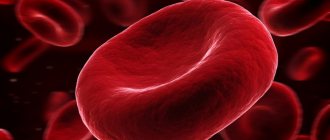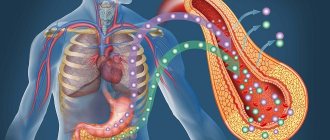What parents need to know
Streaks of blood or clots in small quantities may be observed in the stool itself, color the stool black, or may be released during the act of defecation. To make a correct diagnosis, the doctor will need to ask in detail about the problem.
Parents need to know:
- How long ago did the blood appear?
- how often is it observed;
- how much of it is contained in feces;
- what color is it (red, burgundy);
- in what form they are present in feces (veins, clots);
- Are there any other alarming phenomena: mucus resembling snot, foam;
- character of stool: loose stools or constipation;
- How does the baby feel?
By the color and composition of the blood discharge, you can determine in which parts of the intestine the bleeding is occurring. If violations occurred in the lower sections, then the blood streaks will be scarlet. Black poop indicates problems in the upper intestines.
Immediately after birth, the baby passes the original stool (meconium). It has black color. Normally, it should no longer be there on the 4th day. If meconium appears again after 2 weeks, you should consult a doctor.
Such a disorder can be observed in diseases such as jaundice, hemorrhagic disease, and sepsis.
Diagnosis of baby stool
When a baby has problems with bowel movements, he cannot tell what is bothering him, so parents have to independently determine the problems that have arisen.
Experts warn that there are two most pronounced causes of infant intestinal suffering - colic and constipation, which are interdependent, so it is important that the baby's stool is regular, with the correct texture and color. Specific figures for normal bowel movements depend on the age and individual characteristics of the infant
Many children's doctors call this norm - in newborns, bowel movements in the first month can occur up to five to six times a day, but maybe two, which is also considered normal
Specific figures for normal bowel movements depend on the age and individual characteristics of the infant. Many children's doctors call this norm - in newborns, bowel movements in the first month can occur up to five to six times a day, but maybe two, which is also considered normal.
In general, the following points are important for diagnosing child bowel movements:
- A breastfed newborn should have stool at least twice a day;
- For artificially-bred children, one bowel movement per day is considered completely acceptable;
- The main thing in the characteristics of a child’s stool is not the quantity, but the quality of feces. If the stool is soft and mushy, then the child is considered healthy. If a baby's feces are shaped like a walnut before six months, this indicates constipation;

Normal bowel movements should not cause crying or fussiness in the newborn
Normally, bowel movements should occur calmly, without tension. If the baby cries during bowel movements, tenses, arches his back or pulls his legs towards his stomach, then there is a problem. In this case, it does not matter whether he meets the norm in terms of the number of bowel movements he is supposed to have per day or not.
Children's doctor Komarovsky expresses his opinion on rare bowel movements in infants. He believes that high-quality food in the form of breast milk that an infant takes is almost completely digestible. If the baby is fed breast milk or an adapted formula, and the introduction of complementary foods is correct, then the absence of bowel movements even up to six days is considered normal. The main thing is that the baby does not feel discomfort and is in a good mood.
Cases when you don't have to worry
Stool in healthy newborn babies is light brown in color and has a mushy consistency. A child's poop may change its normal color due to the following reasons.
- Nutrition for a nursing mother. Some foods affect the color of stool. For example, beets, tomatoes. Red veins appear.
- Taking medications: antibiotics, drugs containing iron, activated carbon.
- First complementary foods.
If, after changing your diet and stopping medications, your poop also has blood in it, you should consult a doctor.
Why does a violation occur?
The problem can occur in both bottle-fed and breast-fed babies. If streaks of blood or mucus resembling snot are found in the stool, this may be a symptom of certain diseases. The following reasons can be identified.
- Wounds and fissures of the anus in a child. Streaks of blood begin to appear as a result of frequent constipation.
- Sores in the nipple area of the mother. When breastfeeding, the baby may swallow blood along with the milk.
- Signs of atopic dermatitis. The intestinal mucosa becomes affected by a rash that begins to bleed.
- Dysbacteriosis. Mucus appears, like snot, and red streaks of blood.
- Allergic reaction to cow's milk protein. In this case, in addition to stool disturbances, vomiting is observed. Such protein can enter the body along with the mixture. If a baby is breastfed, protein from the mother's diet will pass into breast milk and then into the baby's body. Peeling of the skin, rash, and redness may occur. The child eats poorly and gains little weight. This condition leads to anemia.
- Inflammatory bowel diseases (eg, colitis). Blood clots do not mix with stool. Loose stools, mucus like snot, vomiting, and loss of appetite are observed. The child is not gaining weight well.
- Intestinal infection. There is a high body temperature, vomiting, loose stools and mucus, like snot, and loss of appetite.
- Pathologies of various parts of the intestine. The condition may be accompanied by high fever, lethargy, loss of appetite, and abdominal pain. There is an admixture of mucus and streaks of blood.
- Lack of vitamin K, which is responsible for blood clotting.
- Helminthiasis. Infection with worms occurs in utero or during childbirth. In addition to blood in the stool and mucus like snot, there is a rash on the body and weight loss.
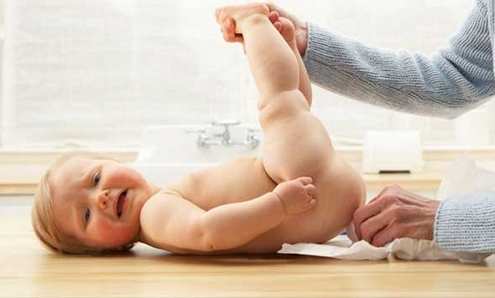
- Polyps in the intestines are accompanied by bleeding. Sometimes blood is not clearly present in the stool. It can be detected during testing (reaction to occult blood).
- Lactose deficiency. The child’s body lacks the enzyme lactase. The poop contains blood, mucus that resembles snot, and lumps of undigested milk. The child is crying, capricious, lethargic, and eating poorly.
You should contact emergency doctors in the following cases:
- diarrhea, mucus (looks like snot) and blood;
- the child vomits;
- body temperature rises sharply;
- pain in the abdomen (the child cries, bends his legs to his tummy).
The reasons for the appearance of stool streaked with blood may be the following:
- Cracks and abrasions in the anal area. Frequent constipation can lead to this problem. The child groans and experiences pain during bowel movements. In these cases, it is enough just to adjust the power supply, and the problem disappears.
- The effect of the allergen on the intestinal mucosa. As a result, it becomes swollen, inflamed, and the stool contains streaks of blood.
- Polyps in the intestines.
- Obstruction of various parts of the intestine.
Reasons for the appearance of blood clots in the stool: internal hemorrhoids, intestinal dysbiosis, colonization of parasites (enterobiasis, ascariasis).

When a child has loose black stools, you should urgently call an ambulance. The condition indicates severe internal bleeding in one of the sections of the digestive tract. The reasons may be the following: stomach ulcer, varicose veins of the digestive system.
Treatment
If, while breastfeeding, the baby develops blood streaks in the stool, therapy depends on the cause that provoked the syndrome. To make it easier for the doctor to make a correct diagnosis, it is better to save some of the newborn’s stool and show it or take a photograph where bloody spots are visible in the stool. Before prescribing any treatment, you will have to undergo the necessary examinations, which are described below.
Diagnostics and tests
To exclude less dangerous diseases during breastfeeding, such as dysbiosis, helminthiasis and ingestion of blood due to cracks in the mother’s nipples, an analysis is performed for dysbiosis, worm eggs and the Apta-Downer test. The latter technique allows you to distinguish blood in the stool that belongs to the baby from the mother’s ichor. To do this, the required part is isolated from the baby’s feces and mixed with a sodium hydroxide solution in a centrifuge. If the mixture turns brown, the blood belongs to the mother, her hemoglobin is present; the preservation of the pink color indicates the presence of the child’s hemoglobin. Blood and urine are also taken for general analysis.
Research methods are as follows:

- Coprogram. To make a diagnosis, the presence in the stool, in addition to blood, of mucous inclusions, undigested breast milk, and remnants of red blood cells is determined. The method is fundamental in the diagnosis of intestinal diseases.
- Coagulogram. It is carried out to confirm or refute bleeding disorders. Prothrombin and thrombin time, fibrinogen are determined.
- Gregersen reaction. Before donating blood, the baby is not fed meat if he is mixed-fed. Allows you to determine hidden blood that is not observed in the stool.
- Tests for lactase deficiency. It is determined how many carbohydrates are contained in the child’s feces, hydrogen in the air exhaled by the baby after lactose has entered the body (breath test), and the process of absorption of D-xylose is assessed.
Additional hardware and laboratory testing techniques depend on the preliminary diagnosis. So, if intestinal obstruction is suspected, an x-ray with a contrast agent is performed.
Treatment methods
The principles of treatment for bloody streaks in the stool depend on the cause that caused the appearance of the alarming sign:
- frequent constipation, leading to cracks in the intestinal and anal mucosa, can be eliminated by adjusting the mother’s diet if the newborn is breastfed and by revising complementary foods with mixed feeding;
- intestinal obstruction is treated surgically, the doctor performs manual straightening of the intussusception;
- therapy for intestinal infections is based on rehydration and antibiotics;
- an allergy to cow's milk is eliminated by replacing it with a highly adaptive hypoallergenic formula, and when breastfeeding, by correcting the mother's diet;
- lactase deficiency is treated by administering lactose-free baby food to the baby - Nutrilon, Humana, Enfamil;
- treatment of hemorrhagic disease is carried out by introducing into the body a synthetic analogue of vitamin K - the drug Vikasol;
- rectal polyps, including juvenile ones, are assessed in terms of size and danger to the baby’s health - the decision on the need for removal is made by the doctor;
- helminthic infestations are treated by taking antiparasitic drugs in children's dosages, maintaining hygiene and limiting contact with the source of infection (it is necessary to deworm pets, boil bed linen, and disinfect the premises).
These are the treatment methods necessary for the appearance of bloody streaks in the stool of infants. Additional medications and methods will be prescribed by the attending physician, depending on the provoking factor.
If it is not possible to immediately determine the cause of the appearance of blood in the baby’s stool, it is better not to refuse hospitalization. In a hospital setting, mothers will be helped to establish the feeding process, monitor the child’s condition, and carry out a wide range of diagnostic procedures. This applies to situations where blood in the stool is accompanied by insufficient weight gain in the infant, poor sleep and appetite, and signs of abdominal pain. Even in the absence of danger symptoms, bloody spots in the baby’s stool should not go unnoticed by parents and pediatricians.
What measures need to be taken
Dangerous symptoms that are accompanied by the appearance of blood in the stool of an infant are: high body temperature, frequent vomiting, diarrhea, pale skin. In these cases, you should definitely contact a specialist.
Self-medication can lead to worsening of the condition and irreversible consequences. You may need to consult an allergist, gastroenterologist, or hematologist.
Additional examination methods will be prescribed:
- Ultrasound of the abdominal cavity.
- Analysis of stool for dysbacteriosis.
- The most effective method is coprogram. According to its data, in most cases it is possible to determine the cause of bleeding.
- General blood and urine analysis.
- Intestinal biopsy. A small piece of the small intestinal mucosa is taken. The procedure is performed under anesthesia.
- Fibrogastroduodenoscopy.
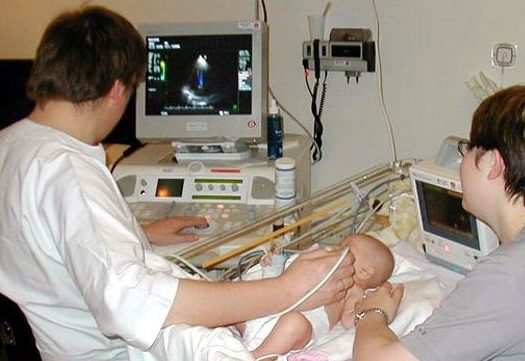
The importance of stool control
Mucus in the feces of infants is not a pathological sign, so its appearance must be assessed in conjunction with other symptoms. If the child is active, has an excellent appetite, sleep corresponds to age standards, nothing threatens the baby’s health. If you have diarrhea, you should not self-medicate, especially experiment with probiotics. All medications must be prescribed by a pediatrician! In case of diarrhea, it is not recommended to limit the child’s feeding and wean him from the breast. Breast milk contains protective components that will speed up the healing process. It’s not for nothing that they say: “The baby’s health is in the mother’s milk.”
What can a coprogram tell you?
Sometimes occult blood is detected in stool tests. A positive reaction to blood becomes a consequence of such serious diseases as cancer of the digestive organs, stomach ulcers, intestinal tuberculosis, and typhoid fever.
A positive reaction to blood is not detected by macroscopic examination. Diagnostic strips are used for this.
Reaction to bilirubin. It can be detected in a baby's stool for up to 3 months. A positive reaction in infants older than 3 months can occur when food passes through the intestines too quickly, or in cases of severe dysbiosis.
Reaction to stercobilin (urobilinogen). This is the end result of the breakdown of hemoglobin in the intestines. A decrease in stercobilinogen indicates liver disease. An increase indicates hemolytic anemia.
Reaction to leukocytes. Their appearance indicates inflammatory processes in the colon.
Stool that contains snot-like mucus may be a sign of:
- dysbacteriosis or lactose deficiency;
- poor mother’s diet (fried, spicy foods);
- intestinal infection;
- respiratory viral diseases (snot, cough).
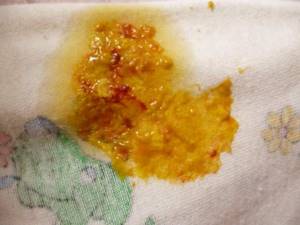
What does mucus look like in stool?
The presence of mucus in a child’s normal stool is not a deviation, but it cannot be detected with the naked eye. If the problem is obvious and constantly reminds you, you should consult a doctor. If, in addition to this, bloody clots are noticeable in the stool, urgent measures must be taken.
The appearance of mucus in stool may vary. The shade of the discharge and its quantity depend on the reason that caused such a manifestation.
The color of mucus may indicate the following disorders:
- Green. Indicates the intensive proliferation of pathogenic microorganisms in the gastrointestinal tract. The symptom often occurs as a consequence of dysbiosis (in this case, a small amount of mucus is released). Copious discharge is characteristic of enteritis and bacterial colitis. The stool emits a sharp, very unpleasant odor.
- Yellow. If a newborn has yellow stool with green lumps, then we are most likely talking about inflammatory processes. Green may indicate an infection; a yellow tint occurs due to a large number of leukocytes trapped in the mucus.
- Pink. This indicates that there is blood in the mucus. This sign may indicate an ulcer, erosion, or Crohn's disease.
- White. Indicates that the discharge contains shed epithelial cells. This may occur due to an allergic reaction of the intestines. White mucus is also characteristic of helminth infection.
- Red. This means that the discharge includes a large number of blood streaks. This sign indicates mechanical damage to the inner surface of the intestine, namely the rectum. This can happen with frequent enemas and the use of gas tubes. Bloody color is also a symptom of Crohn's disease, allergic colitis. With internal bleeding, black or brown mucus is observed in the stool.
In addition to color, mucus is characterized by its consistency. Infection with helminths is characterized by thick, jelly-like discharge. Liquid mucus is a sign of a malfunction of the pancreas, as well as a consequence of lactase deficiency. In acute intestinal infections, instead of feces, only watery mucus is excreted from the body.
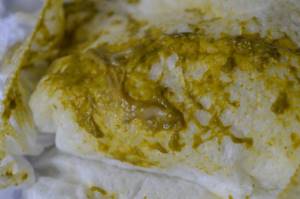
Mucus in baby's stool
Therapeutic measures
In some cases, in order for stool to improve, it is enough just to adjust your diet and lifestyle.
- Stopping all medications.
- Avoiding foods that can turn poop red.
- Intestinal obstruction is treated with surgery.
- Intestinal infection is treated with antiviral drugs, antibiotics and antimicrobial drugs.
- If a child suffers from constipation, the diet should be changed. It is possible to use laxatives (Duphalac, Normaze).
If alarming symptoms appear in a child, parents do not need to panic, even if the child requires hospital treatment. The infant should be closely monitored to ensure the problem is described in detail. This will help make a more accurate diagnosis. You cannot use traditional medicine methods on your own, much less give medications. The condition may worsen and cause complications.
Diarrhea and fever in a child: causes, treatment, algorithm of actions for parents
Diarrhea in a baby is a common occurrence, sometimes resolving with diet. Fever due to intestinal upset in a child is a serious symptom that indicates serious pathologies in the child’s body. Diarrhea and fever require close parental attention. But first you need to establish the cause of the alarming symptoms.
Causes
Children of all age categories are susceptible to diseases that have a similar symptom. But the majority falls on children of primary preschool age.
The reasons that provoked such a reaction of the body may be infectious or non-infectious in nature.
A slight temperature - up to 37 degrees - and diarrhea can be observed with an eating disorder or become a reaction to medications. This disorder goes away within a day. In diseases of the gastrointestinal tract, diarrhea often appears, and the temperature is low or normal. Loose stools caused by these factors disappear on the third day.
An intestinal infection causes severe diarrhea and high body temperature - 39 degrees or higher. If a child’s body is infected, urgent medical attention is required. Diseases caused by infection:
- Rotavirus;
- ARVI;
- Salmonellosis;
- Dysentery;
- Viral hepatitis;
- Scarlet fever, rubella.
Rotavirus
A common disease in young children, also known as intestinal flu. Symptoms of infection: high fever, nausea, vomiting, weakness. On the second day, diarrhea begins. The child is capricious and refuses food. The symptoms of the disease resemble poisoning, but the baby has a fever for five days.
Proper treatment eliminates the disease within a week.
Salmonellosis
Diseases of the digestive system are typical for the summer period. Occurs when consuming low-quality products or products whose expiration date has expired.
The incubation period can last three days. Infection begins in the small intestine. Then it moves to the lymph nodes. The diarrhea is severe with a pungent odor. The baby has a stomach ache and no appetite.
The liver and spleen increase in size.
Dysentery
Bacterial infection is common among preschool children. Easily treatable if diagnosed early. Symptoms of the disease:
- Fever;
- Increased body temperature;
- Weakness;
- Acute diarrhea, with bloody or mucous patches;
- Stomach ache.
If the disease becomes severe, the child may experience seizures.
Children suspected of having the disease are isolated. The diagnosis is made after examination and laboratory tests of the child’s material.
Scarlet fever
The infection is transmitted by airborne droplets. The first signs of the disease appear in the form of headache, vomiting, fever, and diarrhea. After the fever and acute symptoms subside, a small rash appears on the skin. The child has a red throat with pus on the tonsils, the nasolabial triangle is white. The tongue is coated. After a week, the skin of the sick child begins to peel off.
Some signs are characteristic of other diseases. A similar symptom - a rash - occurs with rubella and measles.
Food intoxication
Diarrhea and fever may be accompanied by vomiting due to food poisoning of poor quality. When intoxicated, the limbs become cold and the body becomes covered in sweat.
In case of poisoning, it is not recommended to stop vomiting and diarrhea, since this way the body is cleansed of harmful toxins. All an adult can do is give the child warm, clean water to drink to avoid dehydration.
Parents' actions
If the child is one year old or older, the diarrhea is mild, and the temperature is not high, you can limit yourself to a gentle diet and give the baby more fluids. Symptoms should disappear after a day. If there are signs of infection or poisoning, action must be taken.
First of all, parents should inform the doctor about the illness. Before visiting a doctor, adults can provide first aid to the baby themselves.
It is allowed to give sorbents to the baby. Smecta, Activated carbon are acceptable
It is important to prevent the patient from dehydration. Therefore, it is necessary to replenish the water-salt balance using a rehydration solution
The parent should isolate the child from other family members until the cause of the symptom is determined. You should absolutely not give your baby antibiotics without a doctor’s prescription. It is prohibited to treat intestinal infections on your own.
Diagnosis and treatment
Timely diagnosis and effective treatment are the main tasks for diarrhea. To prescribe the correct therapy, the doctor must find out what disease caused the symptoms.


